WEST COAST TRAIL, Vancouver Island, British Columbia — After our extraordinary Alaskan backpacking experience this past August, my brother and I had become addicted. For months following the excursion, we daydreamed, researched, and gushed about the possibilities for our next adventure. We considered a number of tempting options, including a Grand Canyon rim-to-rim-to-rim hike, a journey along the pristine Lost Coast of California, and even a long trek through remote Patagonia. But then, we read about the Graveyard of the Pacific.
The coastal region between Oregon’s Tillamook Bay and British Columbia’s Vancouver Island in the Pacific Northwest earned its ominous title due to the more than 2,000 ships that have wrecked there since 1800. Due to the rainy, windy, and foggy weather, the Canadian Coast Guard built two lighthouses in the 19th century on Vancouver Island’s western shore in an attempt to warn sea captains of the coast’s imminent dangers, but the improvements were not enough. When 136 people were killed after the S.S. Valencia (and its lifeboats) famously wrecked off the Island’s coast in 1906, the public outcry prompted the Canadian government to build a life saving trail, linking the remote frontier towns of Port Renfrew and Bamfield. The 75-kilometer hiking trail, which included shacks every eight kilometers with blankets and telegraph equipment, made it possible for shipwreck victims to call for help and survive upon arriving ashore in this remote area of Vancouver Island.
The trail, now known as the West Coast Trail, still exists as part of the National Parks of Canada as a well-maintained recreational hiking trail, and we wanted to hike it.
The unique challenges Alaska presented (difficult river and glacier crossings; exhausting, trailless terrain; and complete isolation in the wilderness) made us hungry for one-of-a-kind challenges on the West Coast Trail. When we arrived at the trailhead, Parks Canada gave us and the rest of the “West Coast Trail Class of June 2, 2008” a short presentation about the hike’s dangers. We were warned to use tide tables to time our coastal hiking and avoid being trapped by dangerous swells; we learned that if a helicopter flew overhead dropping tsunami warnings in bottles (seriously!), we would need to immediately drop our backpacks and sprint up towering ladder networks to avoid being swallowed by the sea; we were told to use the cable cars whenever possible to perform river crossings, which made us laugh due to “our extensive river crossing experience”; and we were urged, once again, never to run from a bear (or a wolf or a cougar).
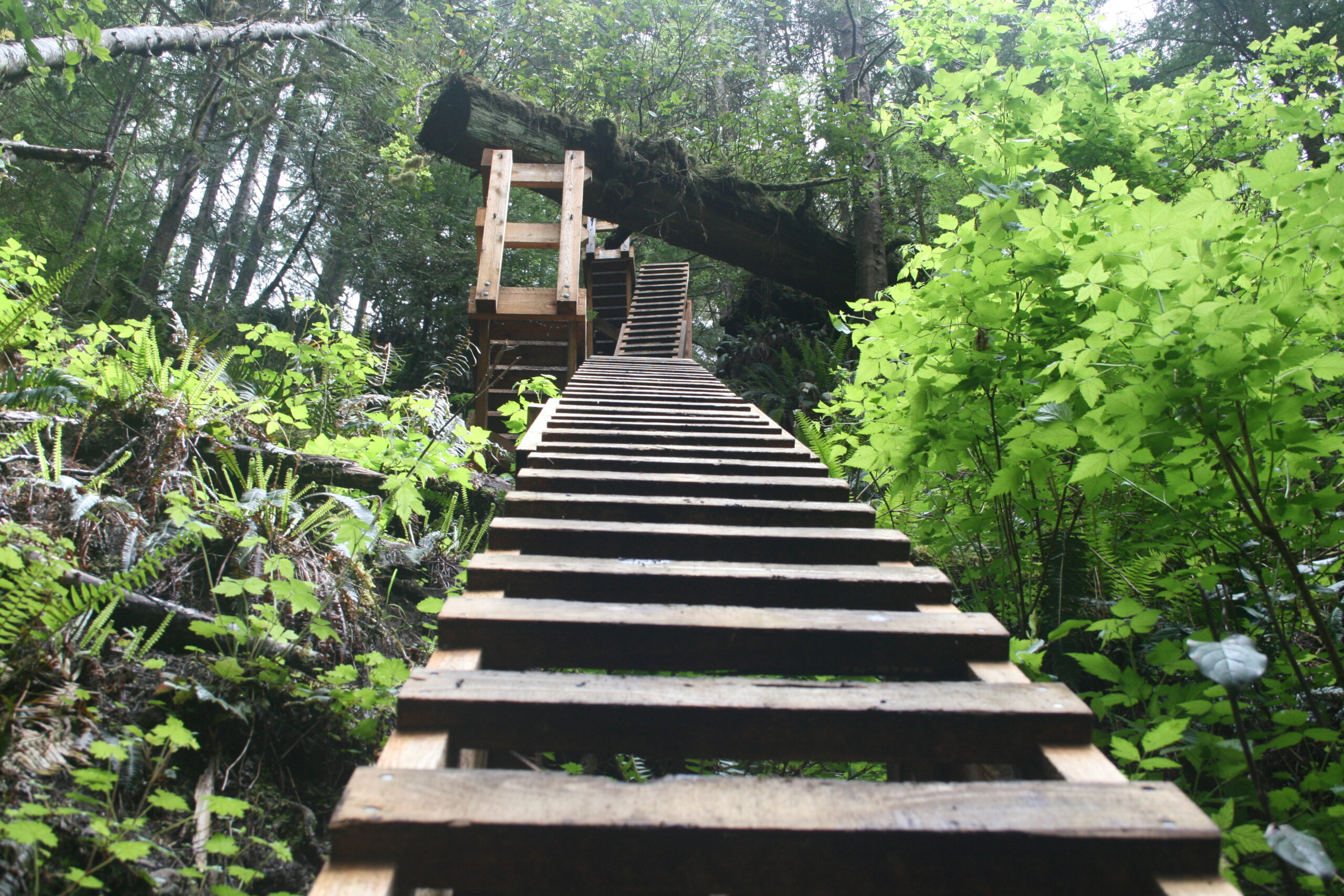
Long networks of ladders are a challenge when wearing heavy backpacks
After the park ranger sufficiently scared us, she sold us our trail permits. We donned our 50-pound backpacks (we were arguably overprepared for this trip, with more than two extra days of food and of course, the requisite board games we always take on backpacking trips) and stepped onto the ferry that took us to the beginning of our adventure.
Hoping to finish the most difficult hiking first, my brother and I started at the harder end of the trail. The trail’s first nine kilometers through the forest gave us a preview of the trail’s unique character. Throughout the forest, enormous fallen trees and logs had been charmingly arranged — we thought maybe by forest elves, but in reality the heavy lifting was probably done by the Canadian park service — to double as bridges and makeshift staircases. We climbed many multi-story wooden ladder networks. We even saw a derelict donkey engine, an old device used for hauling logs in the early 20th century (though we have no idea how it made use of donkeys and engines nor do we have any idea how the darn thing worked at all). The muddy hiking, over enormous tree root systems with lots of uneven terrain, was difficult and tiring, especially with heavy backpacks, but we made it to our first campsite with plenty of time to spare for the day. My brother easily built a campfire with driftwood, and we had a relaxed dinner. As we calmy threw a Frisbee with two girls we met on the beach from Australia and Wisconsin, we realized that despite its difficulty, the West Coast Trail would not even come close to the grueling expedition that was our Alaska trip.
On the second day, we got a taste of why so many ships wrecked along the coast of the Island; in pouring rain and fog, we hiked toward Owen Point on a rocky coastline that looked otherworldly. Carrying the albatrosses that were our heavy packs (curse that extra survival food!), we trudged over miles of treacherous, slippery boulders, some the size of carry-on suitcases, some the size of trucks. We slipped and tripped and fell and fell again. We scraped our arms, bruised our shins, and almost broke limbs tens of times. We even invented a scale of slipperiness, specifically-tailored for the West Coast Trail. The lower end of the scale, “Very Slippery,” was for a typical wet beach boulder. The higher end of the scale, “All Bone-Crushingly Slippery,” was reserved for special boulders covered in algae specifically engineered by nature to render hiking boots useless. As my brother hiked ahead of me, he yelled warnings about specific boulders: “Careful! Fantastically slippery boulder ahead!” Then, he’d fall on his head.
After finishing the arduous and dangerous boulder scrambling, we were met by a collection of surge channels on Owen Point. These channels, worn into the beach rock over hundreds of years, require hikers either to hike on steep forest trails to circumvent them or climb treacherously across them to save time. For the most part, we managed to hike around them, though once we hiked over one by balancing on a log, emboldened by the climbing rope we carried. But after we successfully but barely navigated the log, we deemed the log completely unsafe and vowed never to try crossing a surge channel that way ever again. We later learned that two hikers had tried crossing the same channel we had, fell in, and had to be rescued from the freezing ocean water after nine hours because the channel was too steep for them to climb out.
When we finally arrived after 13 kilometers at our campsite at Camper Bay, exhausted from boulder scrambling and surge channel crossing, we erected our tent, and three men in their fifties (Kurt, Ed, and John) and their sons invited us to enjoy their campfire with them. As we sat in the fire’s warmth and the three drank Jack Daniels from a flask, Ed amazed us when he told us this trip was the fifteenth time he had hiked the trail. Kurt pulled loose pages of the Odyssey from under his “tuque” (a winter hat in Canadian parlance), read them, then burned them. And in the most bizarre display of all, John threw one of his dirty shirts into the fire. “I don’t need it anymore,” he said.
These guys were old-fashioned, manly men. They weren’t lugging emergency food, climbing rope, or board games. I was honored to be in their West Coast Trail “class.”
As we sat with them, I hoped that someday, when my brother and I eventually turned fifty years old, we would still be tough enough to tackle the West Coast Trail, drinking Jack Daniels, reading the Odyssey, and burning our used shirts as we hiked.
Every hike has a worst day
Lighting a fire on a West Coast Trail beach in a rainstorm is not easy.
WEST COAST TRAIL, Vancouver Island, British Columbia — There’s no way around it: by definition, there’s one day in every hiking trip that’s the hike’s worst day. You always know that day’s coming, you just don’t know when and how bad it will be.
My brother and I awoke on the West Coast Trail at kilometer 22 at Walbran Creek, excited and ready to hike to Chez Monique, a “restaurant” unexpectedly located about halfway along the trail in the wilderness. Other hikers had warned us not to expect much; reportedly, the “restaurant” consisted of a few tarps and two propane stoves set up to feed burgers to hikers. Nevertheless, we were looking forward to Chez Monique’s relative comfort, and we took to the forest trail as rain started pouring down.
For most its length, the West Coast Trail has two roughly parallel trails hikers can follow — the forest trail and the beach trail — each with pros and cons. The forest trail often provides more demanding hiking, with uneven terrain, tree roots that cause even the most careful hiker to stumble, and in the rain, gallons of mud everywhere. The beach trail can be sparklingly beautiful, but during storms, the rain and wind are miserable, the soft sand can easily exhaust a hiker after only a short distance, and high tides sometimes make the beach dangerous and completely impassible.
With the rain on the forest trail, we found ourselves trudging through mud deep enough to envelop our hiking boots, and we began trying to develop new mud-walking strategies to streamline our travels. Up until that point, we had been performing what we called “Phase One Mud Walking” — avoiding mud by walking around it as much as possible. “Phase One Mud Walking,” we quickly determined, was problematic in that it took too long and significantly increased our hiking distance. Quickly enough, we invented “Phase Two Mud Walking” — taking the least muddy route one can take without slowing down. Once we were willing to “accept muddy feet”, we left our deep fears of mud behind us and found this system to be much more efficient. Yet “Phase Three Mud Walking” — walking straight through all mud as fast as possible — seemed beyond our comfort-level. We dared not enter Phase Three.
We were ecstatic to be back on the beach and out of the sludge by kilometer 24, until we found ourselves hiking on unprotected coastline in the Strait of Juan De Fuca around Bonilla Point. Rain relentlessly fell on us, wind unyieldingly blew on us, and frustratingly soft sand turned our calf muscles into jelly. Our soaked backpacks seemed to weigh twice their normal weight. With every step we became wetter, crankier, and more tired. The promise of burgers at Chez Monique was the only thing keeping us going.

My brother Brian folds a wet tent in the morning after our hike’s worst day
We slogged ahead. Through the fog, in the distance about two kilometers away, we could barely make out a white tarp. Were we really that close to Chez Monique? As we continued, we realized we had reached the Carmanah Creek campground, and the map showed that we were only one kilometer from the restaurant. As we entered the camp, we had high hopes that we would see other members of our West Coast Trail class. We half-expected to see those manly middle-aged hikers Curt, Ed, and John roasting a whale they had caught with their bare hands on a spittoon they had made from driftwood. We anticipated seeing Larissa and Lis, the girls from Australia and Wisconsin, welcoming us with open arms. Instead, there were no people in sight.
Confused and exhausted, the storm was getting worse: pelting rain, gusts of wind, and soaked sand made the beach hiking grueling. We were so drained that the thought of walking the two kilometers to Chez Monique and back to the campground seemed unthinkable. Disappointed with our stamina, we decided to set up camp, build a warm fire, eat one of our own dinners, and hide from the rain in our dry tent.
Because of the rain, all of the driftwood in sight was soaking wet. I used a hatchet to get some dry cedar chips and small wood shavings from under the outside layer of a piece of driftwood while Brian collected more kindling and built a small fire shelter to keep the kindling dry. As Brian tried to get the kindling to light, I stood near and over the fire to block the wind and heavy rain. Just getting our matches to light was almost impossible because the matches and the strike surface were wet. Even when Brian did get a match lit, he found lighting the wet kindling difficult and burning the wet driftwood nearly impossible.
He was frustrated.
“What is the deal with these matches?!” my brother screamed. “These waterproof matches are not waterproof!” The more he yelled at the matches, the less they seemed to cooperate. Waterproof and windproof matches are only waterproof and windproof, it turns out, once they’re lit. Take one of those matches lit and put it in a wind tunnel or underwater (really!) and you’ll be hard pressed to put it out. But try lighting one in the middle of a storm, and you’ll be wishing for a blowtorch in no time. The wet matches were breaking, bending, making streaks on the strike surface — doing everything matches can do except creating flame. Then, we ran out.
Suddenly, it hit me — this was the hike’s worst day.
Of course, we’re always over-prepared, and I was carrying plenty emergency matches in a waterproof container in my bag. Yet making a campfire was a luxury, and the emergency matches were for cooking meals on our stove — every day for the rest of the trip, we would need at least two matches per day to make a hot breakfast and dinner. But, shivering in the rain, we really wanted that campfire. We agreed to try a couple emergency matches.
After my brother spent over an hour trying to light a fire on the Graveyard of the Pacific in its famously inexorable wind and rain, he succeeded. The newly-dry matches from my bag, in combination with a reworked kindling structure, did the trick. We cheered, tried to warm up and dry off near the fire, and cooked a hot dinner.
We nestled into our dry tent as we listened to the rain gush without stopping for the rest of the day and throughout the entire night. We wondered how our fellow hikers had fared in the storm.
We looked forward to the next day, knowing that burgers at Chez Monique were only a kilometer away. We had already faced the worst day.
Saved by the sun
A sparkling, clear day follows our worst day on the West Coast Trail.
WEST COAST TRAIL, Vancouver Island, British Columbia — For well over eight hours, through a stormy coastal night following our hike’s worst day, my brother Brian and I endured the loud, ceaseless pop, pop, pop of rain pouring on our tent’s rain fly. We nestled in our sleeping bags, remembering the immense value of a warm, dry shelter. Then, as morning broke, the wind slowed and the rhythm of the pop… pop… pop… on the rain fly began to slow and finally stopped. We lazily and reluctantly made our way out of our tent to take a look at the new day.
The bright sun shining down on our beach seemed like a miracle.
Slowly recovering from the soggy night, we sluggishly unpacked our wet clothes, prepared a hot breakfast, and sat in the sun, soaking up the warm rays. After thoroughly drying out and regaining energy, we packed our bags and began walking down the sparkling coast under a crystal blue sky toward Chez Monique. When we arrived at the peculiar “restaurant” in the wilderness, we ordered two enormous $17 cheeseburgers and a couple of beers, despite the nagging feeling that we had to deplete our own food supply as quickly as possible to lighten our packs. As we gazed out into the ocean, Monique (of Chez Monique fame) told us that her husband braved the ocean’s intense storms daily in a tiny inflatable zodiac to transport restaurant supplies (propane, frozen ground beef, and beer) to the island. Based on our experience with the previous day’s typhoon, $17 seemed like a bargain for our two imported burgers. As we ate, we chatted with a Japanese exchange student who worked on Monique’s organic farm as part of a foreign exchange program. We tried to imagine the look on the girl’s face when her university told her, after she had signed up to live in Canada, that she would be growing organic lettuce under a tarp for a woman named Monique cooking frozen burgers on a propane stove in the middle of the Canadian wilderness. There’s no way she could have understood in advance the extent of her predicament, living in a place accessible only by inflatable zodiac and visited only by obsessive backpackers.

Hank looks out at a spectacular coastal view near the West Coast Trail’s halfway point near Dare Point (photo by Brian Leukart)
The exchange student asked how we had braved the previous night’s storm, and we described our fire-lighting difficulties and mentioned that we had lost track of the middle-aged hikers Curt, Ed, and John and the entire Sea to Sky guided hiking group of which Australian Larissa and Wisconsinite Lis were a part.
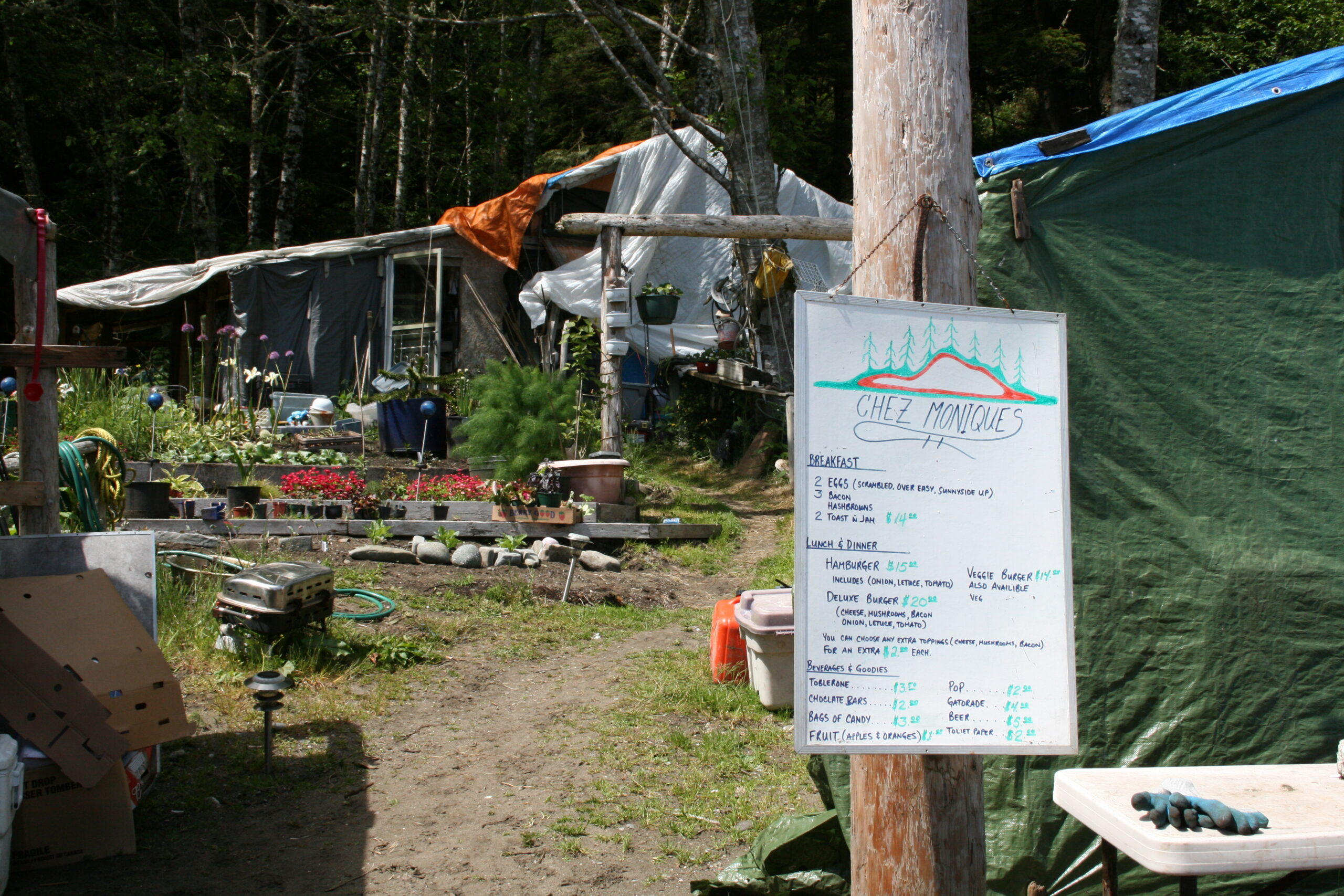
The menu and tarps at Chez Monique
“Sea to Sky? Oh, they stayed with me in my room last night!” The exchange student pointed to a shelter built with logs and tarps. “We made them a big dinner and cheesecake for dessert!”
Brian and I laughed. We couldn’t believe it. Had we hiked only one more kilometer the night before, we would have been sitting dry and warm in a tarp house enjoying cheesecake with our fellow hikers! We determined that their group had cheated and had missed out on an important character-building experience. Of course, the whereabouts of Curt, Ed, and John were still a mystery; we suspected that they were probably 20 kilometers ahead of us, eating Jack Daniels-marinated meat from a grizzly bear they had killed using a bow and arrow fashioned from driftwood.
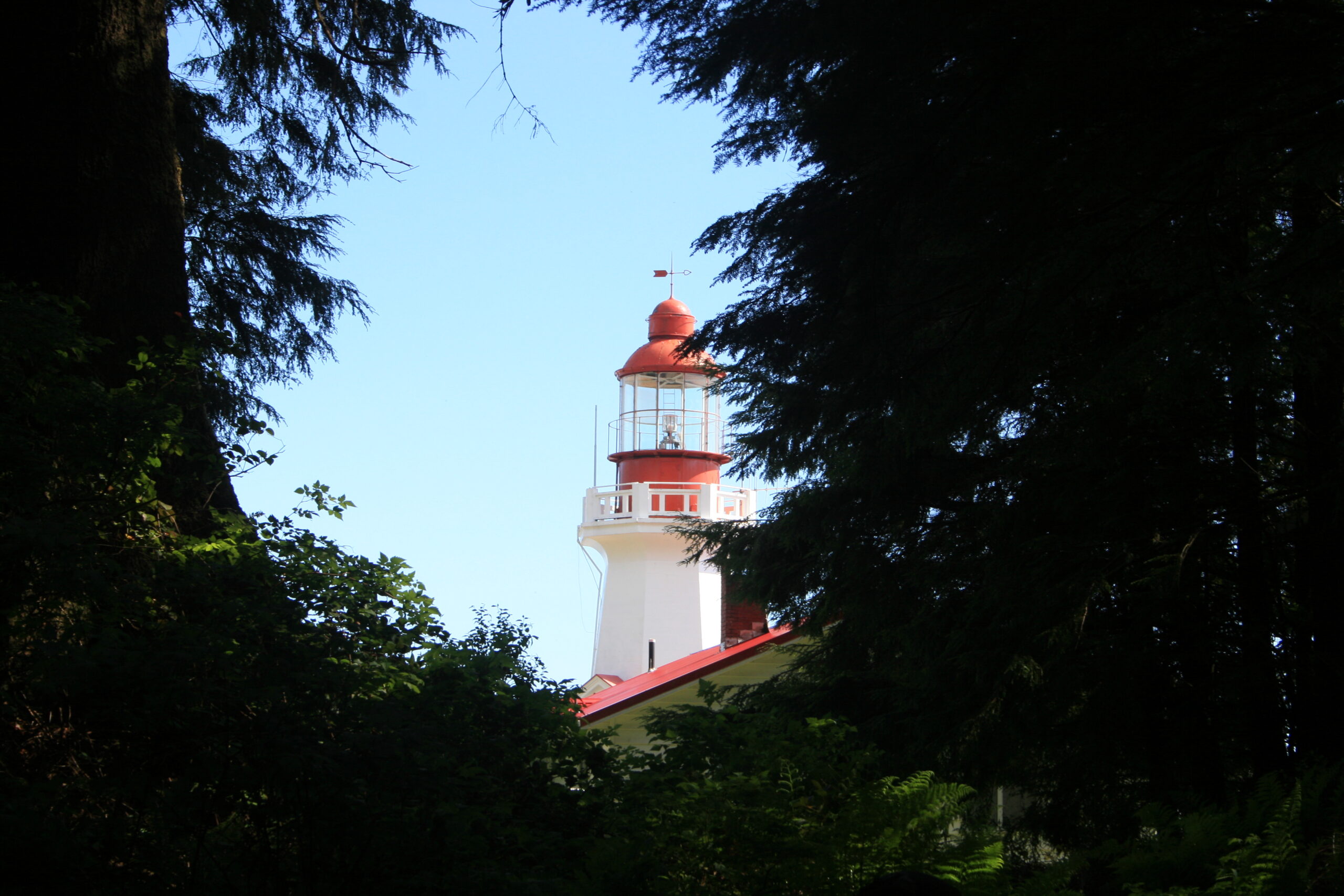
Carmanah Lighthouse peaks out through a gap in the forest
After thanking Monique and her exchange student employee profusely, we continued down the beach. We walked up a cliff above the ocean to visit the gleaming Carmanah Lighthouse, a dazzling white and brick red structure with colors so brilliant we suspected its keepers awoke early each morning at three o’clock to repaint it. When we asked about the diesel generators and helicopter landing pad adjacent to the lighthouse, the keepers told us that due to the lighthouse’s remote location, boats delivered diesel fuel for their electricity generators, and helicopters delivered mail weekly and groceries monthly. I silently wondered what would happen if the owners tried ordering a billiard table from Amazon.com.
Singing a new song we had composed on the fly, “Time to Paint the Lighthouse,” Brian and I continued on the surprisingly firm beach trail under a stunningly cloudless sky, amazed at the energy and stamina the sun brought us. We hiked for what seemed like forever, kilometer after kilometer, never tiring, with Blueberry Crisp Clif Bars to fuel us (these things are amazing!). Even when we arrived at our intended destination, we decided we weren’t tired and continued on to Dare Point, the hike’s halfway point.
On Dare Point, with the calming sound of the surf in our ears on a deserted beach in the wilderness, my brother and I cooked dinner and played board games together as we watched the orange and yellow coastal sun set on the misty horizon. Halfway through our long journey, as dusk fell on us, the West Coast Trail — the so-called Graveyard of the Pacific — became one of the most stunningly picturesque locations on Earth.
A Backwards, Morally-Ambiguous Fairy Tales slumber party
A hilarious story-telling game fuels the end of a long trek.
WEST COAST TRAIL, Vancouver Island, British Columbia — When my brother Brian and I awoke at the West Coast Trail’s halfway point, we knew we had a lot of distance remaining, and we pressed ahead under a cloudy sky toward Tsusiat Falls, a 50-foot flood of clean water shooting over beach cliffs, 14 kilometers away.
On the way to the Trail’s second ferry crossing at the salt water inlet Nitinat Narrows, the trail became easier as we hiked on wooden walkway for several kilometers through an eccentric-looking bog with stunted-growth trees. Brian and I wondered about the kind of terrain under the walkway, terrain apparently so severe that Parks Canada felt it necessary to build a boardwalk through the wilderness. We stepped curiously off the platform, and when our feet touched the ground, we snickered. The bog was covered in “mystery mattress,” a terrain officially known as taiga — the same terrain we trudged through, without any walkways, for 55 miles in Alaska. Proud of ourselves that we had hiked for many days over ground in Alaska that here Parks Canada had deemed impassable, we were nevertheless relieved that we did not have to battle what we referred to as Nature’s Stairmaster again.
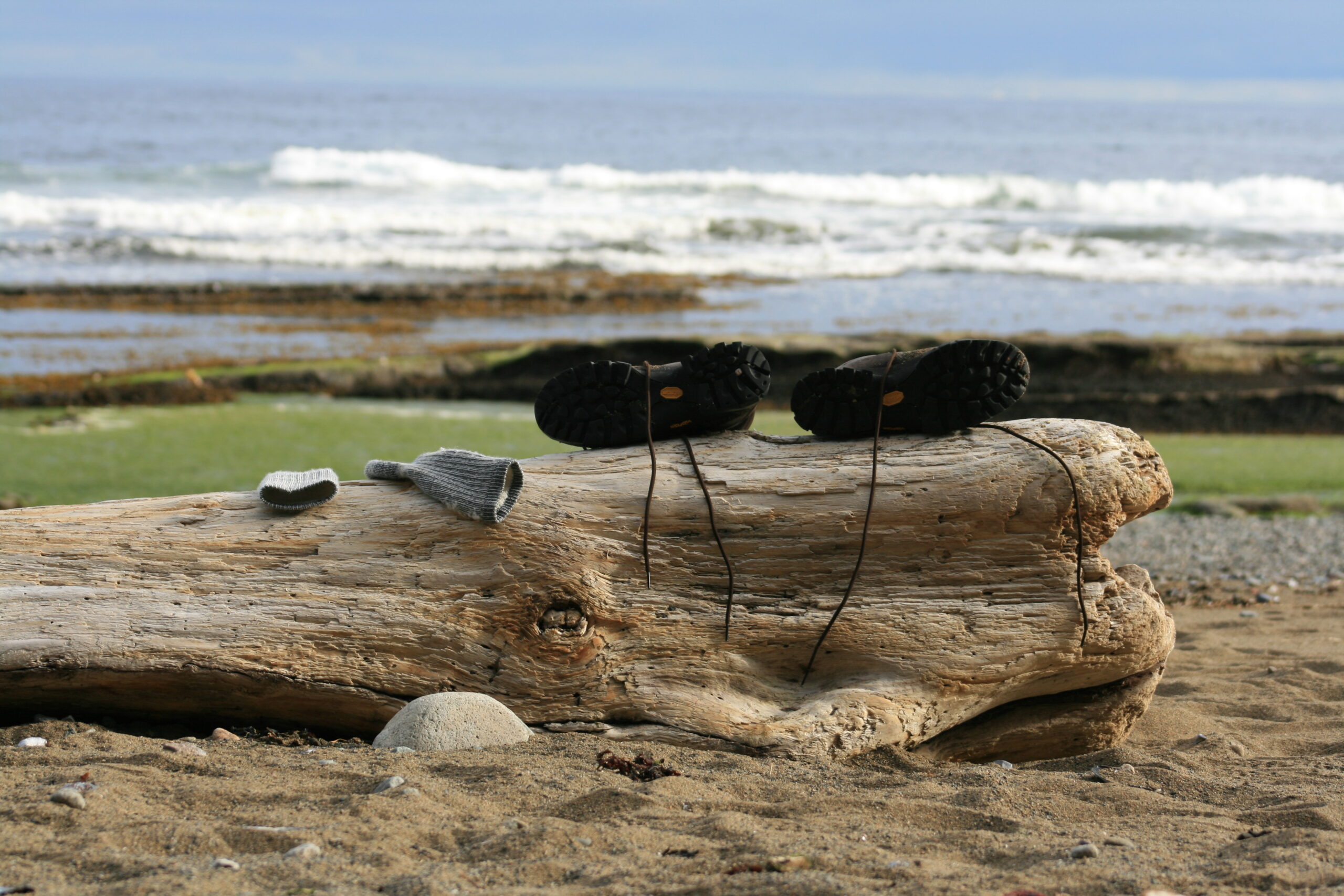
Socks and boots dry in the sun near the West Coast Trail’s Michigan Creek (photo by Brian Leukart)
When we reached Nitinat Narrows, we rested on a tiny wooden ferry dock as the ferry captain caught and cooked us a large, salty crab for lunch. The crab was tasty, but with every ounce of crab meat we ate, the emergency food supply in our packs felt an ounce heavier.
When we finally arrived at Tsusiat Falls, we were surprised and excited to find the Sea to Sky group with Australian Larissa and Wisconsonite Lis, huddling in a cave eating dinner near the Falls. Thrilled to see us, they offered us some of their dinner, which we ate despite our continuing desperation to get rid of our own food. (At that point, we had started to suspect that we could have survived months on the trail with the amount of food in our packs.) We tried to entertain them with stories of our rainstorm survival and descriptions of our slipperiness scale and mud-handling techniques, and we reprimanded them for their “cheating” — eating cheesecake in a tarp house during the downpour.
Later, while my brother set up our tent, I, having not bathed since the hike’s beginning, took our biodegradable Dr. Bronner’s Peppermint Liquid Soap and walked to the waterfall. I stripped off my clothes, lathered up, and stood in the river under the falls, with near-freezing water enveloping my body. Shivering and tingly (Dr. Bronner’s Peppermint is strange stuff), I walked back to the campfire, refreshed and ready for the hike’s final days.
That night, Larissa and Lis joined us in the dark by our campfire. We begged them to eat some of our dried fruit and shared a freeze-dried raspberry crumble dessert with them, anxious to eradicate food weight. As we ate, Larissa told us about her corporate consulting job and her dream to become a doctor eventually, Lis talked about her time in the Peace Corps in Africa and her later decision to go to law school, and my brother and I also described our recent career shifts.
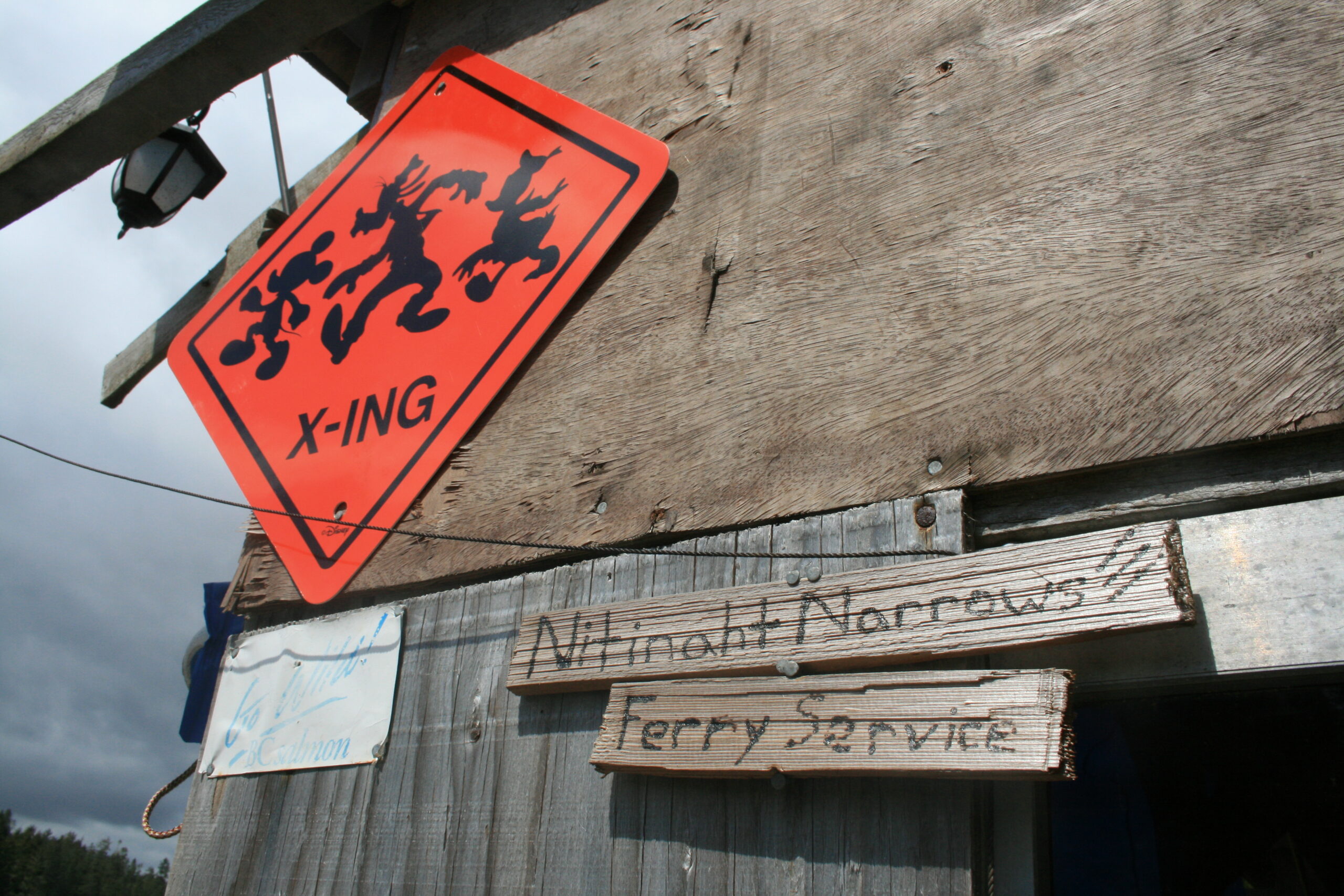
The ferry crossing at Nitinat Narrows
Apparently, there’s nothing like hot, tangy, mushy raspberry crumble to catalyze a quarter-life crisis bonding moment. We were drunk with gooey raspberry goodness.
After a refreshing night next to the soothing sound of the waterfall, my brother and I awoke to another beautiful day with 25 kilometers and two days of hiking remaining. As we hiked toward our final campsite at Michigan Creek, we began playing a storytelling game that we affectionately titled Backwards, Morally-Ambiguous Fairy Tales. To play the game, two or more people take turns telling parts of a story, but there are three important catches.
First, the story must be told in a particular format (“Once upon a time…”/”And every day…”/”And then…”/”And then…”/”Until one day…”/”And because of that…”/”And because of that…”/”And ever since that day…”). Second, the story must be told in reverse, so that the first person to take a turn concocts the end of the story and the last person to take a turn invents the story’s beginning. Third (and possibly the most fun), the story must include morally ambiguous characters or elements.
On the way to Michigan Creek, my brother and I recounted the story of Santa Claus becoming leader of an elf forest to save the elves from an evil dictator, though he was motivated by dubious political aspirations. (Remember, in Backwards, Morally-Ambiguous Fairy Tales, even Santa Claus is not a completely scrupulous guy.) We described events surrounding a post-apocalyptic world in which wolves and cougars plotted to overthrow a donkey hegemony. (What could be more morally ambiguous than a political power struggle?)
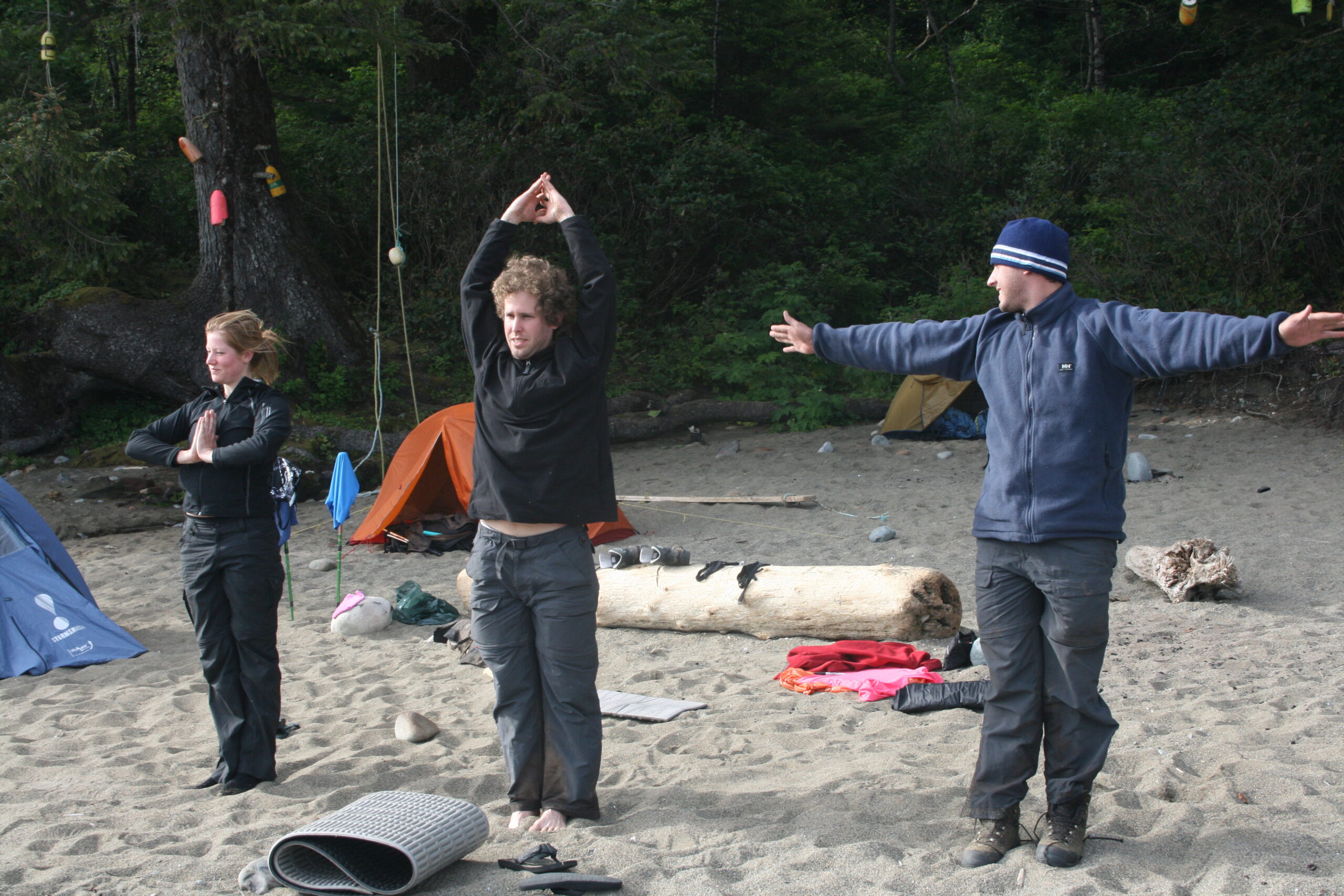
A strangely uncoordinated beach yoga session after a long hike
We told a fable explaining how mice developed their teeth, about a teenage beaver and mouse who fell in love in Animal High School, despite the disapproval from their parents of interspecies relationships. (Anthropomorphic animals are a hallmark of famous fables by Greek writer Aesop and modern fable author Rudyard Kipling.) We even narrated a story about an evil team of scientists who created grizzly bear clones and also manufactured bear-proof food containers and bear-proof screwdrivers. (Plot points involving cloning are always an easy way to introduce moral ambiguity to the game.)
With the hilarity of Backwards, Morally-Ambiguous Fairy Tales driving us, we hiked forward without even stopping for lunch, and we arrived at Michigan Creek with a beautiful afternoon to spare. We were not surprised to find the manly middle-aged hikers and their sons already relaxing on the beach, petting their new pet wolf and eating a refreshing lunch of pure granite boulders. They didn’t even look tired.
After assembling our tent, we caught sight of Larissa and Lis on the shore, stretching their sore muscles. We grabbed our sleeping pads, walked over to them, and playfully suggested an ocean-side yoga class. Quickly, we were all doing sun salutations on the beach, looking out into the ocean. Off shore, whale fins jutted above the sea’s surface and water sprayed into the air from whale spouts.
As darkness fell, the four of us squeezed into a single tent. Below a moonlit sky, with the sound of the ocean outside of the tent, we had a Backwards, Morally-Ambiguous Fairy Tales slumber party. We stayed up late, laughing hysterically about our strange, invented tale of the trials of a Grapefruit Queen. It was the last night of our unique journey on the West Coast Trail. We never wanted it to end.
Thanks very much for your account of the trail — and your excellent pictures. I will be hiking the WCT with two friends next week and am very much looking forward to it. Reading journals of others is the best way to prepare for a strenuous hike.
Sounds like a great trip. I really enjoy your writing style. It has a nice rhythm.
Great story and wonderful photos.I want to do this trip now more than ever. Thanks for the inspiration.
Rhi.
Hey, thanks for this trip report. I've wanted to do this trail for a long time. Did you have any problems getting your permits? I've heard they sell out very quickly and people can wait several seasons to get them?